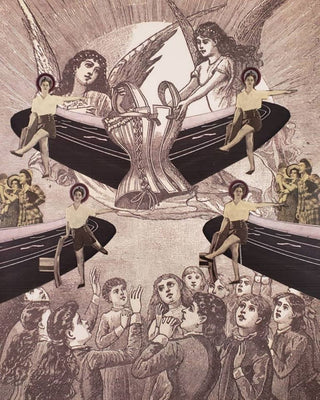
Lisa Sheets
Bio
My background is in music, art and psychology. I earned a BA in Psychology and Art (sculpture and printmaking emphasis) with a minor in Music (flute) from Western Illinois University. Following that I completed an MFA in cast metal sculpture at Southern Illinois University-Carbondale.
In the 1990s I owned Smart Art Studio/Gallery in Pioneer Square, Seattle, WA, and in 2000 I created an art resource for workshops and art studio rentals called Artspawn Studios in Woodinville WA. Since then I have worked in collage, book arts, and printmaking.
My sculptures are in the collections of the Cities of Kirkland, Redmond, and Mountlake Terrace. My collages are in the collections of the State of Washington, University of Washington Medical Center , University of Washington Book Arts Collection, the Doug + Laurie Kanyer Art Collection, Seattle City Light Portable Works Collection, and the National Museum of Women in the Arts in Washington DC.
Artist Statement
These collages are my subconscious’ ongoing communication about relationships, culture, and my own life. They are autobiographical; some reflecting images of me in different roles and interacting with different historical backdrops. I enjoy the combination of religious art historical iconography, and pop culture images, to stress the sacred in our modern day life. These collages are more akin to dreams in the use of space and symbols.
After many years working primarily as a sculptor, I started making collagraph prints in about 1994. Using collage started out as simply a way to add an interesting image to my collagraph print. Over time, my collagraph prints became more and more mixed media, until they were combinations of printmaking, Xerox transfer, painting, and collage. Lately, my work is almost 100% collage. I’ve gradually been collecting hundreds of images for use in my collages, and I’m always on the look out for more. I find them in old magazines, books, advertising flyers, and recently, in online image databases.
For me, creating these images is a form of dialoguing with myself about inner conflicts. Certain key images take on deeper meaning for me, like the lady diver, or the group of women gathered in a rowboat. Even the inclusion of handwriting as a part of the image refers both to communication, and to a part of our culture that is rapidly becoming anachronistic. I like the pattern as a background for my collages, and I also like to include handwriting because it is something we are losing touch with. Our computer driven culture is leaning towards typing and emailing as our main form of communicating. I still think script has a personality all its own that reflects the writer much more intimately. My use of religious iconography reminds us that no matter what mundane daily tasks we are engaged in, there is an aspect of the sacred in each movement, each choice we make in our human existence.
While working on a new collage, I have an assortment of images all around me, which I choose from to find images that play off of each other in sometimes cognitively dissonant ways. These images are never planned out in advance, but happen much more spontaneously. This is why I prefer the cut and paste method of collage over using a computer to manipulate the images. I like the physical act of layering all these different images together, until I find a fit that’s just right.

Please wait, it may take sometime ...
1-Always Use "Landscape" mode Layout in print settings.
2-Use default margins.

Lisa Sheets
These collages are my subconscious’ ongoing communication about relationships, culture, and my own life. They are autobiographical; some reflecting images of me in different roles and interacting with different historical backdrops. I enjoy the combination of religious art historical iconography, and pop culture images, to stress the sacred in our modern day life. These collages are more akin to dreams in the use of space and symbols.
After many years working primarily as a sculptor, I started making collagraph prints in about 1994. Using collage started out as simply a way to add an interesting image to my collagraph print. Over time, my collagraph prints became more and more mixed media, until they were combinations of printmaking, Xerox transfer, painting, and collage. Lately, my work is almost 100% collage. I’ve gradually been collecting hundreds of images for use in my collages, and I’m always on the look out for more. I find them in old magazines, books, advertising flyers, and recently, in online image databases.
For me, creating these images is a form of dialoguing with myself about inner conflicts. Certain key images take on deeper meaning for me, like the lady diver, or the group of women gathered in a rowboat. Even the inclusion of handwriting as a part of the image refers both to communication, and to a part of our culture that is rapidly becoming anachronistic. I like the pattern as a background for my collages, and I also like to include handwriting because it is something we are losing touch with. Our computer driven culture is leaning towards typing and emailing as our main form of communicating. I still think script has a personality all its own that reflects the writer much more intimately. My use of religious iconography reminds us that no matter what mundane daily tasks we are engaged in, there is an aspect of the sacred in each movement, each choice we make in our human existence.
While working on a new collage, I have an assortment of images all around me, which I choose from to find images that play off of each other in sometimes cognitively dissonant ways. These images are never planned out in advance, but happen much more spontaneously. This is why I prefer the cut and paste method of collage over using a computer to manipulate the images. I like the physical act of layering all these different images together, until I find a fit that’s just right.








